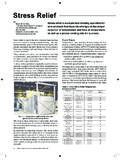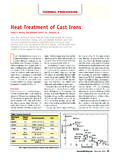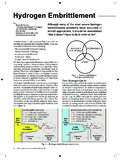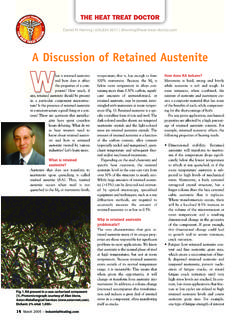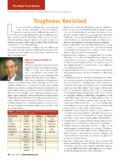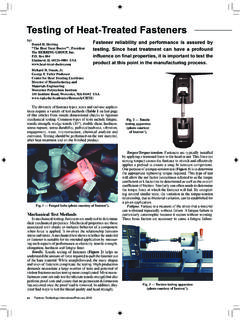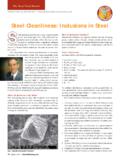Transcription of Heat Treating of Aluminum Castings T - Heat Treat Doctor.com
1 He heat treatment of cast aluminium alloys (Ta-ble 1) is carried out to increase their strength and hardness and to change their physical, mechani-cal and metallurgical properties. Let s learn more. Different types of Castings require different thermal Treat -ments (Fig. 1). For example, improved mechanical and physical properties can be produced in sand and permanent-mold cast-ings by heat treatment. By contrast, some alloys such as that contain little or no copper, zinc or magnesium do not respond to heat Treat -ment and do not exhibit improvements in mechanical properties. Others, such as die Castings , can only be given a stress relief (and not solution heat treated) because of their porous internal structure due to fears of surface blistering and internal porosity.
2 Each type of heat treatment is worth un-derstanding in more TreatmentSolution Treatment TB Condition (T4) Castings are heated to a temperature just below the alloy melt-ing point (dependent on chemical composition) and held at this temperature (dependent on alloy and cross-sectional thickness) a suffi cient amount of time to allow the alloying elements to enter into solid solution. Upon quenching, these elements are in a super-saturated metastable state. Quench media include water, boiling water or polymer. Choice of the quenchant is often a balance between achieving mechanical properties and managing distor-tion while avoiding the buildup of internal stresses in the part.
3 Although mechanical properties increase somewhat by natural aging, precipitation hardening (artifi cially aging) is typically em-ployed to achieve maximum benefi t to the mechanical (Aging) TE Condition (T5 or T51)Artifi cal aging treatment is carried out at temperatures above am-bient, typically in the range of 150-200 C (300-400 F). This type of heat treatment is done at these relatively low temperatures to eliminate growth. They are also used to stabilize the Castings di-mensionally (improving mechanical properties somewhat) and to improve machinability. Soak (hold) times can vary between two and 24 hours depending upon the alloy and the cross-sectional thickness of the part.
4 Lower temperatures and longer times pro-mote precipitation and often enhanced mechanical properties. Solution Treated and Stabilized TB7 ConditionAfter solution treatment, Castings can be heated into the range of 200-250 C (400-480 F) for stabilization and homogenization of the alloying elements. Times and temperature vary with the type of alloy and mass of the Treatment and Precipitation Hardening TF Condition (T6 or T61)Solution treatment followed by precipitation (age) hardening pro-duces the highest strength and mechanical properties (tensile and yield strength) while retaining ductility (elongation). Precipita-tion (age) hardening stabilizes the Treated and Stabilized TF7 Condition (T7 or T71) Castings used for elevated-temperature service may benefi t from a solution treatment and stabilization between 200-250 C (400-480 F) in order to stabilize mechanical properties when the com-ponent is exposed to temperatures close to or in this range.
5 This heat treatment improves mechanical properties to a large degree, stabilizes the Castings and usually results in a slightly lower tensile and yield strength but an increased elongation value compared to the T6 series of heat Relief and Annealing TS ConditionStress relief and annealing can be used to remove stresses in a casting or to soften the component for subsequent shaping or mechani-cal-working operations. Stress relief is typically performed between 200-250 C (400-480 F) while annealing is done around 300-400 C (575-750 F).Heat Treating of Aluminum CastingsDaniel H. Herring | 630-834-3017 | Heat Treat DoctorTable 1.
6 Classifi cation of thermal treatments of cast Aluminum alloys Suffi x DesignationHeat TreatmentMNone As cast or as manufacturedTB (T4)Solution treated and naturally agedTE (T5)Artifi cially agedTB7 Solution treated and stabilizedTF (T6)Solution heat treated and fully artifi cially agedTF7 Solution treated and artifi cially aged and stabilizedTSStress relieved and annealedhbhcTTStress Relief and Annealing Stress relief and annealin a castfor scal-wtypica(400-48around ly agednd stabilized22 February 2010 - 1. Cast Aluminum engine block (Photograph Courtesy of Wisconsin Oven Corporation; East Troy, Wis.)Heat Treat 221/21/10 10:41:55 AMTH rialH Alloy SelectionAluminum casting alloys (Table 2) are numbered in accordance with a three-digit-plus-decimal designation in order to identify major alloying elements (and some alloy combinations).)
7 The digit following the decimal in each alloy number indicates the form of product. 0 indicates the chemistry limits ap-plied to an alloy casting. 1 indicates the chemistry limits for in-got used to make the alloy casting. 2 indicates the chemistry limits for ingot are different (typically tighter). Generally, the designation indi-cates the ingot is supplied as a secondary product ( , remelted from scrap), where-as the designation suggests the in-got is produced from primary Aluminum . Some alloy names are preceded by a letter so as to distinguish between alloys that differ only slightly in percentages of im-purities or minor alloying elements ( , , , or ).
8 In order to choose the alloy, casting process and heat treatment, the engineer begins by understanding the service con-ditions under which the component part will operate. In order to achieve the de-sired strength, hardness, corrosion resis-tance, impact strength or machinability, designers have over 60 casting alloys in use today and up to fi ve different heat Treat -ments they can select (Table 3 online). Sometimes one mechanical property ( , yield strength) dictates alloy choice and/or casting method. In most cases, Aluminum Castings are chosen as the most cost-effective solu-tion based on raw material and produc-tion cost.
9 However, knowledge of end-use service requirements and how to optimize design effi ciency and/or lower production costs in manufacturing ( , reproducibil-ity) may change the design. For instance, a casting with sound design may have a size or shape that will promote distortion in heat Treating . A wide variety of appli-cations (Table 4, Fig. 2) are possible. Casting method is also an important consideration. For example, Castings re-quired in large quantities favor perma-nent molds, die casting or automated sand casting (provided the size and de-sign features of the casting and available alloys are suitable). Sand casting often is used to produce parts with hollow cavities and a complex arrangement of ribs or pockets and for parts unsuitable for casting in metal molds.
10 Sand cast-ing usually requires minimum tooling charge, but the unit price of the Castings and the fi nished part can be high. Per-manent mold casting requires a higher tooling charge, but the unit price is lower, particularly for longer runs. Die casting usually requires the highest tooling charge but also the lowest piece price on large quantities. IHFig. 2. Load of Aluminum Castings for heat treatment at a commercial shop(Photograph courtesy of Wisconsin Oven Corporation; East Troy, Wis.)Table 2. Cast Aluminum alloy designationsSeriesAlloy Al (minimum) + + Si-Mg or Si-Cu or + + + + 4. Typical applicationsAlloyTypical / heads, generator housings (aircraft), pistons (aircraft, diesel, motorcycle)Applications where strength and hardness at high temperatures are / / / 320 Sand Castings : crankcases (internal combus-tion and diesel Engines), pans (oil), tanks (gasoline and oil) Permanent mold Castings : engine compo-nents (various), heads (water-cooled cylin-der), housings (rear axle)Applications where moderate strength is required.
